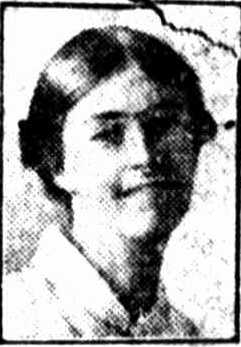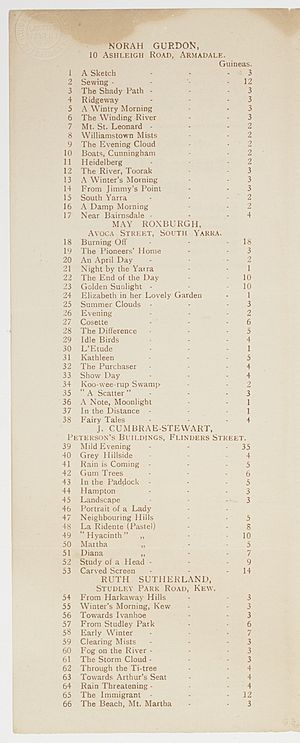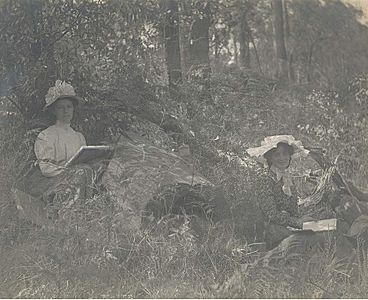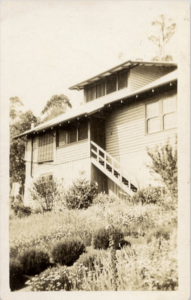Norah Gurdon facts for kids
Norah Gurdon (born between January and March 1882 – died June 27, 1974) was a talented Australian artist. She was known for her beautiful paintings, especially portraits, and also for her weaving. Norah received a special award, the British Victory Medal, for helping during World War I.
Quick facts for kids
Norah Gurdon
|
|
|---|---|
 |
|
| Born | Jan-March 1882 Norfolk, England
|
| Died | 27 June 1974 Kalorama, Victoria, Australia
|
| Education | National Gallery Art School |
| Known for | Painting, Portraiture, Weaving |
| Movement | Impressionism, Post-Impressionism, Heidelberg School |
| Awards | British Victory Medal for services during the war |
Contents
Norah Gurdon's Early Life
Norah Gurdon was born in Norfolk, England, in early 1882. Her parents were Dr. Edwin John Gurdon and Ellen Ann Randall. She was the second of four children. In 1886, when Norah was about four years old, her family moved to Ballarat, Victoria, Australia. They traveled on a ship called the Carlisle Castle. The family later settled in Brighton, where her father worked as a doctor from their home. Norah showed a strong artistic talent early on, even while attending Brighton High School for Girls.
Norah Gurdon's Artistic Journey
Norah Gurdon studied art at the National Gallery School from 1901 to 1908. She learned from famous artists like Frederick McCubbin and Bernard Hall. During her studies, she became friends with other artists such as Jessie Traill, Dora Wilson, Constance Jenkins, and Janet Cumbrae Stewart. These friendships lasted her whole life.
Norah was very good at painting landscapes (scenes of nature) and still-life (pictures of objects). She started showing her artwork with the Victorian Artists Society even while she was still a student. In 1909, she won a major award for her oil painting at the City of Prahran's Art Exhibition Prize. The next year, she rented an art studio in Collins Street with her friends Janet Cumbrae Stewart and Jessie Traill. Norah was also an important member of the Melbourne Society of Painters and Sculptors. In 1913, she exhibited her work with a group called "Twelve Melbourne Painters."
Norah Gurdon During World War I
In 1914, Norah traveled to England with her sister Winifred. She planned to continue her art training there. However, World War I started just ten weeks after they arrived, and Norah and her friend Jessie Traill were unable to return home. Norah decided to help by becoming a volunteer nurse with the British Red Cross. She worked in a French military hospital for three and a half years. For her service, she received the British Victory Medal.
During the war, much of her painting focused on landscapes from her travels in England and Scotland before the war began. After the war ended in 1920, she stayed in Europe to paint scenes in Scotland, Suffolk, and Cornwall. Norah traveled overseas many times. In 1927, she met fellow artists Pegg Clarke and Dora Wilson in Rome. She also traveled to Norway and Sweden in 1938, just before World War II began, safely avoiding that conflict.
Life and Art at Kalorama
Unlike many women artists of her time, Norah Gurdon never married. She was also financially independent, meaning she earned her own money and didn't rely on anyone else. In 1922, she bought land in the Dandenong Ranges at Kalorama, planning to build her dream home there. Once the house was finished, she lived there with her sister Winifred. Many of her artist friends, and even her former teachers and students, would visit. They often painted landscapes outdoors together, a style known as plein air painting.
Norah painted in an impressionist style, like many artists of her time. However, she preferred using soft blue and grey colors to capture the beauty of the Dandenong hills. She also loved handicrafts, spending her free time designing and making her own floor rugs and mats on tapestry looms.
- Selected photographs
Norah Gurdon's Exhibitions
Norah Gurdon was a very active and successful artist who showed her work often. She exhibited with groups like the Victorian Artists Society, the Melbourne Society of Women Painters and Sculptors, and the Australian Art Association. In the 1920s, she had many solo exhibitions (shows featuring only her work) at the Athenaeum Gallery. She also showed her art at the Women's Industrial Arts Society in Sydney and the Royal Queensland Art Society in Brisbane. In 1937, she held a special exhibition at the Fine Arts Gallery to help raise money for building St George's Hospital in Kew.

Norah Gurdon's art was displayed in many places over the years, including:
- 1909: The Waddy Club, Melbourne
- 1911: City of Prahran Art Exhibition (where she won First Prize in Oils)
- 1913: Twelve Melbourne Painters, Athenaeum Gallery, Melbourne
- 1920: Solo exhibition, Athenaeum Gallery, Melbourne
- 1921: Solo exhibition, Queensland Art Society's Gallery, Brisbane
- 1923: Solo exhibition, Athenaeum Gallery, Melbourne
- 1925: Solo exhibition, Athenaeum Gallery, Melbourne
- 1927: Solo exhibition, Athenaeum Gallery, Melbourne
- 1929: "Record of a short tour abroad," Solo exhibition, New Gallery, Melbourne
- 1932: Hand weaving exhibition (where she showed woolen rugs)
- 1937: Solo Fundraising exhibition for St George's Hospital, Fine Art Society's Gallery, Melbourne
- 1943: Solo Fundraising exhibition for Red Cross Prisoners of War Fund, Sedon Gallery, Melbourne
- 1949: Dandenong Ranges Group Handicrafts Exhibition (where she showed floor rugs and weavings)
- 1949: Solo Fundraising exhibition for "Food for Britain Fund" and "Church of England Diocesan Homes for Elderly People," Sedon Gallery, Melbourne
- 1977: "Project 21: Women's Images of Women," Art Gallery of New South Wales, Sydney (a show after her death)
- 2021: "Her Own Path," Bayside Gallery, Melbourne (a recent exhibition celebrating her work)
Norah Gurdon's Art Collections
Norah Gurdon's artwork is kept in several important art collections. These include the Shepparton Art Museum, Yarra Ranges Regional Museum, Castlemaine Art Gallery, National Gallery of Victoria, Bendigo Art Gallery, Benalla Art Gallery, and the Brighton Historical Society.






